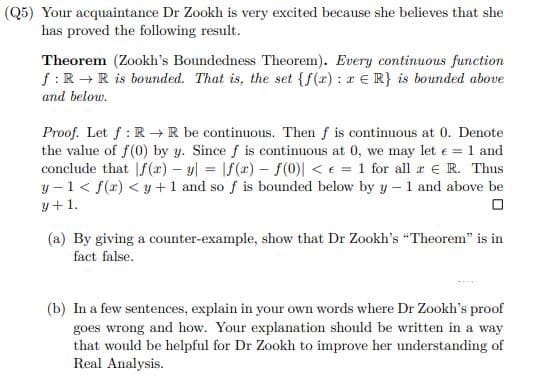(Q5) Your acquaintance Dr Zookh is very excited because she believes that she has proved the following result. Theorem (Zookh's Boundedness Theorem). Every continuous function f: R+R is bounded. That is, the set {f(x): r ER} is bounded above and below. Proof. Let f: R→ R be continuous. Then f is continuous at 0. Denote the value of f(0) by y. Since f is continuous at 0, we may let € = 1 and conclude that f(x) - y = f(x)-f(0)| <= 1 for all z € R. Thus y-1
(Q5) Your acquaintance Dr Zookh is very excited because she believes that she has proved the following result. Theorem (Zookh's Boundedness Theorem). Every continuous function f: R+R is bounded. That is, the set {f(x): r ER} is bounded above and below. Proof. Let f: R→ R be continuous. Then f is continuous at 0. Denote the value of f(0) by y. Since f is continuous at 0, we may let € = 1 and conclude that f(x) - y = f(x)-f(0)| <= 1 for all z € R. Thus y-1
College Algebra (MindTap Course List)
12th Edition
ISBN:9781305652231
Author:R. David Gustafson, Jeff Hughes
Publisher:R. David Gustafson, Jeff Hughes
Chapter3: Functions
Section3.3: More On Functions; Piecewise-defined Functions
Problem 99E: Determine if the statemment is true or false. If the statement is false, then correct it and make it...
Related questions
Question

Transcribed Image Text:(Q5) Your acquaintance Dr Zookh is very excited because she believes that she
has proved the following result.
Theorem (Zookh's Boundedness Theorem). Every continuous function
f: R → R is bounded. That is, the set {f(x): r ER} is bounded above
and below.
Proof. Let f: R→ R be continuous. Then f is continuous at 0. Denote
the value of f(0) by y. Since f is continuous at 0, we may let € = 1 and
conclude that f(x) - y = f(a) f(0)| <= 1 for all x € R. Thus
y-1<f(x) <y+1 and so f is bounded below by y-1 and above be
y + 1.
0
(a) By giving a counter-example, show that Dr Zookh's "Theorem" is in
fact false.
(b) In a few sentences, explain in your own words where Dr Zookh's proof
goes wrong and how. Your explanation should be written in a way
that would be helpful for Dr Zookh to improve her understanding of
Real Analysis.
Expert Solution
This question has been solved!
Explore an expertly crafted, step-by-step solution for a thorough understanding of key concepts.
Step by step
Solved in 3 steps

Recommended textbooks for you

College Algebra (MindTap Course List)
Algebra
ISBN:
9781305652231
Author:
R. David Gustafson, Jeff Hughes
Publisher:
Cengage Learning

Linear Algebra: A Modern Introduction
Algebra
ISBN:
9781285463247
Author:
David Poole
Publisher:
Cengage Learning


College Algebra (MindTap Course List)
Algebra
ISBN:
9781305652231
Author:
R. David Gustafson, Jeff Hughes
Publisher:
Cengage Learning

Linear Algebra: A Modern Introduction
Algebra
ISBN:
9781285463247
Author:
David Poole
Publisher:
Cengage Learning
